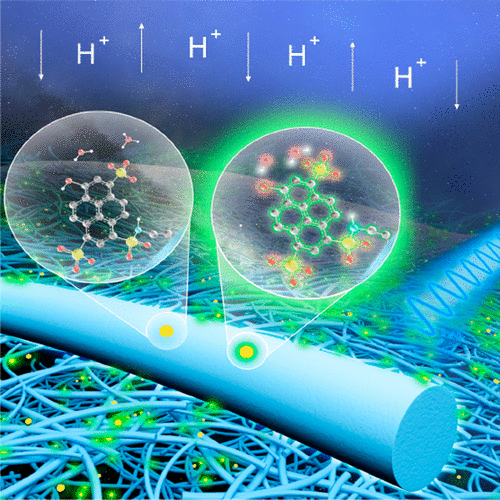当前位置:
X-MOL 学术
›
Chem. Rev.
›
论文详情
Our official English website, www.x-mol.net, welcomes your feedback! (Note: you will need to create a separate account there.)
Optical Sensing and Imaging of pH Values: Spectroscopies, Materials, and Applications
Chemical Reviews ( IF 62.1 ) Pub Date : 2020-11-04 , DOI: 10.1021/acs.chemrev.0c00451 Andreas Steinegger 1 , Otto S Wolfbeis 2 , Sergey M Borisov 1
Chemical Reviews ( IF 62.1 ) Pub Date : 2020-11-04 , DOI: 10.1021/acs.chemrev.0c00451 Andreas Steinegger 1 , Otto S Wolfbeis 2 , Sergey M Borisov 1
Affiliation

|
This is the first comprehensive review on methods and materials for use in optical sensing of pH values and on applications of such sensors. The Review starts with an introduction that contains subsections on the definition of the pH value, a brief look back on optical methods for sensing of pH, on the effects of ionic strength on pH values and pKa values, on the selectivity, sensitivity, precision, dynamic ranges, and temperature dependence of such sensors. Commonly used optical sensing schemes are covered in a next main chapter, with subsections on methods based on absorptiometry, reflectometry, luminescence, refractive index, surface plasmon resonance, photonic crystals, turbidity, mechanical displacement, interferometry, and solvatochromism. This is followed by sections on absorptiometric and luminescent molecular probes for use pH in sensors. Further large sections cover polymeric hosts and supports, and methods for immobilization of indicator dyes. Further and more specific sections summarize the state of the art in materials with dual functionality (indicator and host), nanomaterials, sensors based on upconversion and 2-photon absorption, multiparameter sensors, imaging, and sensors for extreme pH values. A chapter on the many sensing formats has subsections on planar, fiber optic, evanescent wave, refractive index, surface plasmon resonance and holography based sensor designs, and on distributed sensing. Another section summarizes selected applications in areas, such as medicine, biology, oceanography, bioprocess monitoring, corrosion studies, on the use of pH sensors as transducers in biosensors and chemical sensors, and their integration into flow-injection analyzers, microfluidic devices, and lab-on-a-chip systems. An extra section is devoted to current challenges, with subsections on challenges of general nature and those of specific nature. A concluding section gives an outlook on potential future trends and perspectives.
中文翻译:

pH 值的光学传感和成像:光谱、材料和应用
这是对 pH 值光学传感方法和材料以及此类传感器应用的首次全面综述。该综述首先介绍了 pH 值的定义、pH 值光学检测方法的简要回顾、离子强度对 pH 值和 p K a值的影响、选择性、灵敏度、此类传感器的精度、动态范围和温度依赖性。常用的光学传感方案将在下一个主要章节中介绍,其中的小节介绍基于吸收测量法、反射测量法、发光、折射率、表面等离子体共振、光子晶体、浊度、机械位移、干涉测量和溶剂化显色的方法。接下来是关于在传感器中使用 pH 值的吸光度和发光分子探针的部分。进一步的大章节涵盖了聚合物主体和载体,以及指示剂染料的固定方法。进一步和更具体的部分总结了双功能材料(指示剂和主体)、纳米材料、基于上转换和 2 光子吸收的传感器、多参数传感器、成像和极端 pH 值传感器的最新技术。关于多种传感格式的一章包含关于平面、光纤、倏逝波、折射率、表面等离子体共振和全息术的传感器设计以及分布式传感的小节。另一部分总结了在医学、生物学、海洋学、生物过程监测、腐蚀研究等领域的选定应用,包括使用 pH 传感器作为生物传感器和化学传感器中的传感器,以及将它们集成到流动注射分析仪、微流体设备和实验室中。片上系统。一个额外的章节专门讨论当前的挑战,并有小节讨论一般性质的挑战和特定性质的挑战。结论部分对未来潜在趋势和观点进行了展望。
更新日期:2020-11-25
中文翻译:

pH 值的光学传感和成像:光谱、材料和应用
这是对 pH 值光学传感方法和材料以及此类传感器应用的首次全面综述。该综述首先介绍了 pH 值的定义、pH 值光学检测方法的简要回顾、离子强度对 pH 值和 p K a值的影响、选择性、灵敏度、此类传感器的精度、动态范围和温度依赖性。常用的光学传感方案将在下一个主要章节中介绍,其中的小节介绍基于吸收测量法、反射测量法、发光、折射率、表面等离子体共振、光子晶体、浊度、机械位移、干涉测量和溶剂化显色的方法。接下来是关于在传感器中使用 pH 值的吸光度和发光分子探针的部分。进一步的大章节涵盖了聚合物主体和载体,以及指示剂染料的固定方法。进一步和更具体的部分总结了双功能材料(指示剂和主体)、纳米材料、基于上转换和 2 光子吸收的传感器、多参数传感器、成像和极端 pH 值传感器的最新技术。关于多种传感格式的一章包含关于平面、光纤、倏逝波、折射率、表面等离子体共振和全息术的传感器设计以及分布式传感的小节。另一部分总结了在医学、生物学、海洋学、生物过程监测、腐蚀研究等领域的选定应用,包括使用 pH 传感器作为生物传感器和化学传感器中的传感器,以及将它们集成到流动注射分析仪、微流体设备和实验室中。片上系统。一个额外的章节专门讨论当前的挑战,并有小节讨论一般性质的挑战和特定性质的挑战。结论部分对未来潜在趋势和观点进行了展望。


























 京公网安备 11010802027423号
京公网安备 11010802027423号